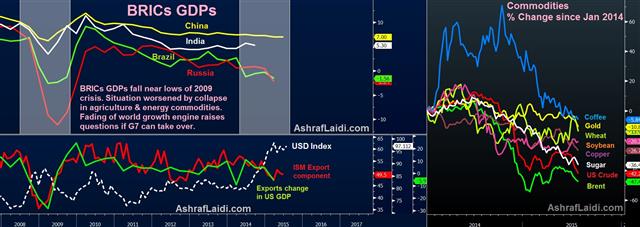Commodities Damage to BRICs Cushion
Aside from $ trillions in monetary stimulus from the world's major central banks, a major source to the recovery from the 2008-9 global financial crisis emerged from the BRICs economies. The dependence on commodities exports from Brazil, Russia and China proved instrumental in these economies' rapid comeback thanks to the cushion from rapid gains in agricultural and energy prices from 2002 to 2008. But now that agricultural commodities have crashed, metals crumbled and energy plunged, what becomes of the BRICs engine to the world economy?
BRICs Damaged by Commodities
Russia continues to depend on oil and gas with 83% of exports coming from commodities. Brazil never diversified away from its dependence on iron ore, soya, coffee and sugar and boasts a 64% commodities/exports ratio. Chinese exports of refined oil and metals have fallen substantially, driving the 3-month moving average of year-on-year exports growth to -2.0%, compared to a range of +20-30% in 2010-2013. India remains the BRICs bright spot due to broad policy reforms and a higher dependence on commodities imports (not exports).Not Like 2009
The charts of the BRICS GDPs below show that growth in Brazil and China has dropped back to the levels of the 2009 crisis lows. Russia is in recession but the main reason its contraction isn't as deep as in 2009 is that oil prices have not suffered the extent of the peak-to-trough collapse of 2008-2009. Whether we'll see a repeat remains to be seen.US Multinationals Suffer Strong USD & Lower EM Demand
In the US, the strong dollar has already dealt its punishment to US exports, as seen in the export component of the GDP and export index of the manufacturing ISM. The combined effect on US exports from the strong USD and lower EM demand doesn't appear promising. This also applies to weak Chinese demand, exacerbated by plunging stock market values. Tech blue chips such as Apple and Twitter relying on China will inevitably confront fading demand.As the Fed readies to assess the positives of falling US unemployment and new lows in jobless claims, it will be reminded by the resurfacing dangers of importing deflation. Unlike in 2008, when the US fell into crisis with a cheap US dollar and higher inflation, none of those cushions exist today, at home or at EM.

| Act | Exp | Prev | GMT |
|---|---|---|---|
| Continuing Jobless Claims (JUL 10) | |||
| 2.207M | 2.225M | 2.216M | Jul 23 12:30 |
| Initial Jobless Claims (JUL 17) | |||
| 255K | 280K | 281K | Jul 23 12:30 |
Latest IMTs
-
30 yrs of Gold under 4 Minutes
by Ashraf Laidi | Dec 13, 2025 12:29
-
AAOI & the Fed
by Ashraf Laidi | Dec 11, 2025 19:22
-
3 Qstns for Today's Fed Meeting
by Ashraf Laidi | Dec 10, 2025 15:40
-
5 Stocks Worked for me Best in 2025
by Ashraf Laidi | Dec 5, 2025 14:42
-
Silver 150 Highly Plausible
by Ashraf Laidi | Dec 4, 2025 11:19







